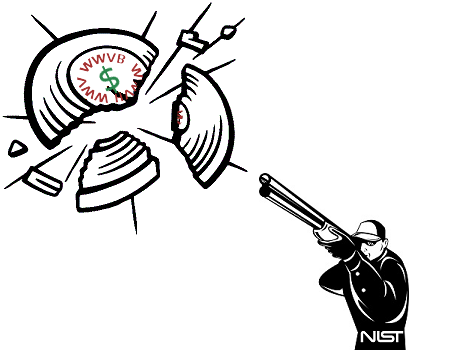WWVB DX club membership declined
For years my friends have demonstrated the ability to listen to the 60 kHz WWVB NIST time signal out of Colorado. Until now I never had a receiver capable of dialing down that low. Triggered by all the hoo ha of NIST’s threat to shutter the WWVB and WWV/H stations, I suddenly desired to experiment with these transmissions a bit. Thinking the world of SDR devices promise a low cost way to capitalize on these emissions, especially WWV, I purchased some offerings from various vendors.
Enter the AIRSPY HF+
Among the choices was the Airspy HF+ that features a zero-IF mode to help detect frequencies below the usual SDR low limit near 30 MHz. I won’t repeat the various features here since their web site contains ample hints…
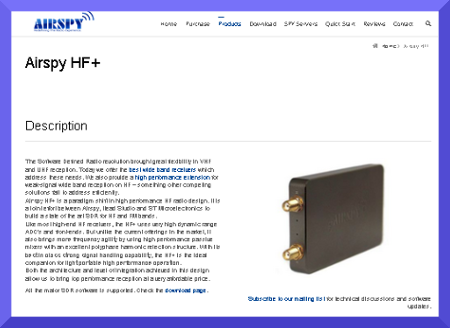
It comes with two SMA connectors: one for VHF, the other for HF and down… way way down so I discovered.
My review of the Airspy HF+ is for another post. Needless to say this product is impressive.
Hookup to a 43 foot vertical antenna
To get things going I shared my 43 foot antenna with the Airspy HF+ and my Heathkit GC-1000 WWV receiver. Here it is with cabling reasonably dressed and USB cable wandering rightward towards a PC…
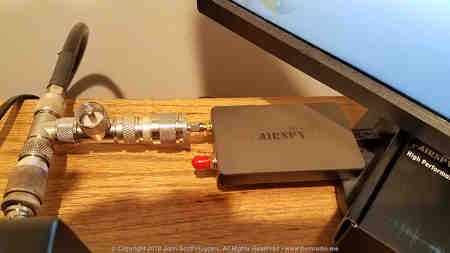
Mating an SMA with a UHF Connector… just doesn’t seem right does it?
My 43 foot antenna is the type with a impedance transformer at the base and no active tuning. Broadband? Let’s see what happens.
Airspy SDR Sharp (aka SDR#)
I downloaded the Windows tools from Airspy. They do not have a traditional install so I unzipped them into my personal applications directory in My Documents. I fired up the SDSharp.exe file and, boom, the Airspy HF+ was found and ready to use.
I stumbled my way down the bands passing shortwave stations, WWV (15, 10, 5 and 2.5 MHz), several AM broadcast stations, and past the NDB beacons. All good so far. Wow!
First time hearing WWVB with my own gear
With some trepidation I adjusted the frequency controls lower still. In between some stronger signals I looked for some evidence of energy at 60 kHz… and there it was!
Click any image to enlarge.
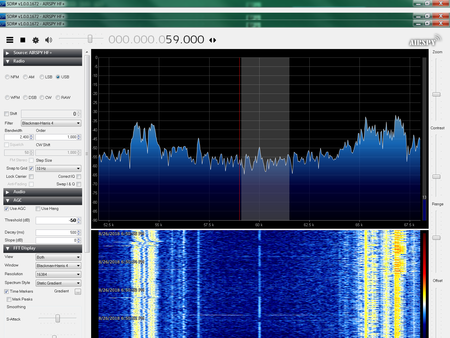
The frequency is tuned down a bit with SSB decode to render an audible tone varying with the amplitude encoding.
Let’s see a full WWVB frame
Using SDR#’s (version 1.0.0.1672) controls, I enlarged and slowed the waterfall to encase an entire minute.
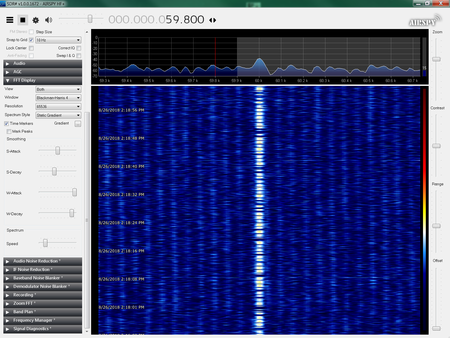
If you carefully compare the signal in the waterfall to the encoding format found on Wikipedia’s WWVB article you can piece together the time to the minute, day of year and two digit year…

Let’s frame the signal received above…

Now let’s decode the relevant parts…

The time code encoded in the waterfall works out to…
- 10 + 8 = 18 minutes,
- 10 + 8 hours UTC,
- 200 + 30 + 8 days = 238th day of year,
- 10 + 8 = 18 two digit year.
This yields 1818 UTC or 1418 EDT or 2:18 pm in Virginia… a good match to the time stamps (based on NTP) in the waterfall in figure 4.
Cool man!
A complete SWL station
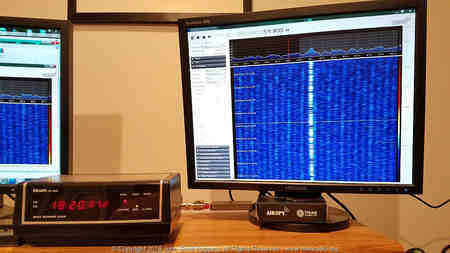
What’s old is old. What’s new in shortwave listening, let alone LF and VHF+ reception, is as easy as connecting an appropriate antenna to the Airspy HF+, firing up Airspy SDR# and start searching for signals on the waterfall.
Conclusion
The Airspy HF+ is about two hundred bucks! More than a little, less than a lot. For this money you alleviate the need for an up-converter with, apparently, no penalty in sensitivity. Yeah you have to know which antenna port does what, and the documentation is a bit spartan at Airspy, but this is about as simple as it gets.
I always wondered just how difficult it is to discern the newer WWVB signal using traditional amplitude comparison. Judging by the waterfall you could decode it one second at a time with ease. Yeah I have a large antenna helping bring that signal in, but it’s nice to see it so pronounced in the display.
Thank you Airspy… WWVB is in the log thanks to your slick HF+ SDR receiver.
